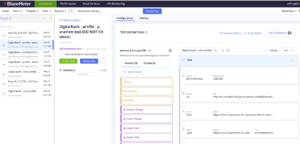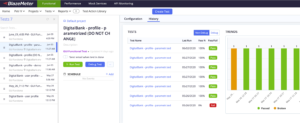Regardless of the application that needs testing, companies need compliant test data to adequately test applications. For example, such data might take the form of a user ID and password, a person’s name, a phone number, a credit card number or a Social Security number.
The challenge for companies is to figure out where to get such data. In many cases, companies pull data from actual production records; however, using real data forces them to mask it in order to ensure that the data is non recognizable to meet security and compliance regulations. Such processes make generating test data difficult, time consuming, costly and challenging.
Alternately, companies can synthetically create test data; however, doing so has required a specialized skill set, driving up the cost and slowing the process for generating the necessary data.
Announcing BlazeData, A new way to create test data
Since the expansion of BlazeMeter to a Continuous Testing Platform in late 2019, one of the biggest “asks” we’ve heard from users is the need for test data that can be easily generated by developers, testers and testing teams, while also meeting all compliance-related regulations. Our users also want a way to easily attach this data to their tests. We have listened to our users!
We’re excited to announce the release of BlazeData, which lets users of all skill levels quickly and synthetically generate data for any UI functional test. No specialized training needed! Other types of testing will utilize BlazeData in the coming months, including regression, performance and end-to-end testing.
Every test requires data
Test Data is a critical and integral part when creating tests, so it’s important to keep your test data under control across your test environment and all its components. BlazeData opens new options to easily define, maintain and get desired test data for your tests. Make your tests and test scenarios more robust and comprehensive than ever before.
BlazeData provides a number of benefits to businesses, including:
- Ease of use: BlazeData provides a simple graphical-user interface (GUI) menu-driven option for users to quickly and
 easily generate and link test data to any test.
easily generate and link test data to any test. - No specialized training necessary: BlazeData can be used by testers with limited technical understanding, as well as by highly experienced test data engineers.
- Lowered costs: Traditionally, generating large amounts of test data is cost prohibitive, especially whenfactoring in the time it takes to generate data manually. Externally generated data can be imported into the BlazeMeter platform, but this adds another layer to the process.
- Reusable data: Once data is created, it can be used repeatedly for other tests that you might want to perform, such
 as feature updates. For instance, if you need to make an update to an app’s feature, you might create test data that includes first name, last name, a login and a password. BlazeData allows you to save that test data so it can be used on repeat tests.
as feature updates. For instance, if you need to make an update to an app’s feature, you might create test data that includes first name, last name, a login and a password. BlazeData allows you to save that test data so it can be used on repeat tests. - One-stop shop solution: We’ve developed BlazeData as a unique solution in the marketplace that creates a one-stop shop for your entire testing process. Users simply go to the BlazeMeter platform, log in and start testing almost immediately.
Looking to revolutionize how to build and link test data to your tests? BlazeMeter, with it BlazeData functionality, is your answer. Through the BlazeMeter Continuous Testing Platform, data generation is easily enabled to generate data for your tests. To get started for free, head over to BlazeMeter.com.
The post Solving the big challenge: Where do I get test data? appeared first on SD Times.
from SD Times https://ift.tt/3qr0QXN
Comments
Post a Comment